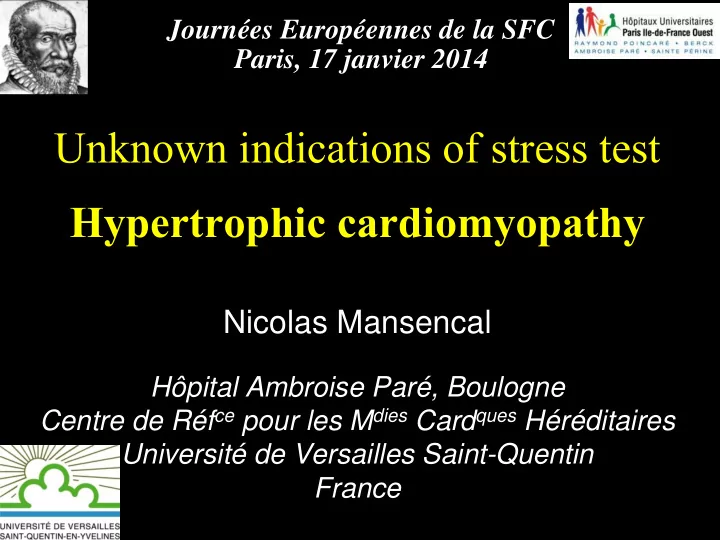

Journées Européennes de la SFC Paris, 17 janvier 2014 Unknown indications of stress test Hypertrophic cardiomyopathy Nicolas Mansencal Hôpital Ambroise Paré, Boulogne Centre de Réf ce pour les M dies Card ques Héréditaires Université de Versailles Saint-Quentin France
Déclaration de Relations Professionnelles Disclosure Statement of Financial Interest J'ai actuellement, ou j'ai eu au cours des deux dernières années, une affiliation ou des intérêts financiers ou intérêts de tout ordre avec une société commerciale ou je reçois une rémunération ou des redevances ou des octrois de recherche d'une société commerciale : I currently have, or have had over the last two years, an affiliation or financial interests or interests of any order with a company or I receive compensation or fees or research grants with a commercial company : Company Affiliation/Financial Relationship • • Grant/Research Support N.A. • • Consulting Fees/Honoraria Bracco Imaging, MSD, Astrazeneca • • Major Stock Shareholder/Equity N.A. • • Royalty Income N.A. • • Ownership/Founder N.A. • • Intellectual Property Rights N.A. • • Other Financial Benefit N.A.
Classification Cardiomyopathies HCM DCM ARVC RCM Unclassified Familial/Genetic Non-familial/Non-genetic HCM: • Characterized by abnormal wall thickness (LV, predominating in IVS) • Most frequent cause of sudden death in athlete < 35 yo Elliott et al. Eur Heart J 2008
www.has-sante.fr August 2011 November 2011
Why and which explorations? • Why? 1. To perform the diagnosis of HCM 2. To assess the presence/absence of gradient 3. To assess the risk of sudden death • Which? – ECG – Echocardiography (± contrast LVO) – Cardiac magnetic resonance (doubt) – Exercise test / Exercise echocardiography – 24 – hour ambulatory (Holter) ECG monitoring
Echo diagnosis Major criterion Non familial HCM: Thickness > 15 mm Familial HCM: Thickness > 13 mm Associated measurements • LVEDD ≤ 45 mm • Pattern of hypertrophy – symmetric LVH: IVS/PW ≤ 1.3 – asymmetric LVH: IVS/PW > 1.3 • Diastolic dysfunction • Gradient > 30 mmHg E A E A E A IVRT DeT IVRT DeT IVRT DeT
LV outflow tract gradient • 2/3 had no gradient • Assessment of SAM • The gradient is highly variable: – 12 HCM during 5 days versus 5 AS – Mean coefficient of variation: 0.52 ± 0.33 – Mean coefficient of variation in AS: < 0.10 – A single measurement is inadequate Kizilbash Circulation 1998 • Gradient varies with exercise, load conditions and is related to Σ • Significant gradient: > 30 mmHg Maron Circulation 2012
Canepa Am J Cardiol 2013
320 HCM REST: 320 63% without and 37% with >50 mmHg 119 11 190 ≥50 mmHg < 30 mmHg 30-49 mmHg EXER 201 47% without and 52% with > 30 mmHg 76 95 30 < 30 mmHg ≥50 mmHg 30-49 mmHg 95 pts (30%) without and 225 pts (70%) with > 30mmHg Maron Circulation 2006
Post-prandial exercise Feiner J Am Coll Cardiol 2013
HCM and gradient assessment • Examination • Echocardiography • Provocation test: – Physiologic test: Exercise echocardiography – Pharmacologic test (nitrite, Dobutamine infusion) • CMR imaging Writing Committee Members Circulation 2011
Patients with HCM and angina-like symptoms Argulian Prog Cardiovasc Dis 2012
Athlete’s heart or HCM? No gradient If gradient HCM Moderate LV hypertrophy Recommandations SFC 2007
Athlete’s heart or HCM Athlete’s heart HCM • • IVS < 13 mm IVS > 15 mm • • Symmetrical LV hypertrophy Asymmetrical LV hypertrophy • • LV diameter > 55 mm LV diameter < 45 mm • • Normal diastolic function Abnormal diastolic function • • Normal left atrium Dilated left atrium • • No symptoms Symptomatic • • No previous history of HCM/SD Previous history of HCM/SD • • Normal ECG, exercise test , Abnormal ECG, exercise test , holter ECG holter ECG • • Decreased wall thickness with No decreased wall thickness deconditionning with deconditionning Grey zone
LVOT gradient & exercise • In subjects without HCM: Prevalence of gradient: 5 à 13 % • Predisposing factors of occurrence of this gradient: Morphology of the left ventricle & mitral valv. • Interpretation performed according to: • Type of exercise • Intensity of exercise • Abrupt discontinuation (or not) of exercise • Time of onset of the gradient (during exercise or recovery) Zywica et al. Eur J Echocardiogr 2008; Cabrera Bueno Rev Esp Cardiol 2004
Sudden death and HCM Identification of high-risk patients: 5 variables related to sudden death: History of syncope + familial history of sudden death (multivariate SD risk ratios = 5.3) LV thickness > 30 mm (RR = 2) NSVT (Holter ECG monitoring) (RR = 1.9) Abnormal exercise blood pressure (RR = 1.8) Elliott J Am Coll Cardiol 2000
Severe LVH NSVT SCD Exercise test Syncope O’Mahony Heart 2013
• Age-sex predicted METs achieved (p = 0.0001) • Abnormal heart rate recovery at 1 min (<12-beat drop,p = 0.007) • AF (p = 0.007) Desai J Am Coll Cardiol Img 2013
Stress testing Class IIa • Treadmill exercise testing is reasonable to determine functional capacity and response to therapy (LoE: C) • Treadmill testing with monitoring of an ECG and blood pressure is reasonable for SCD risk stratification (LoE: B) • In patients without resting peak instantaneous gradient of greater ≥ 50 mm Hg, exercise echo is reasonable for the detection and quantification of exercise induced dynamic LVOT obstruction (LoE: B)
Examinations for follow-up Baseline examinations: ECG Echocardiography Exercise test (BP) Holter ECG No symptoms, no risk factors: Echocardiography (/y), exercise test and Holter ECG (/2-3y) At least 1 risk factor or symptoms: Echocardiography (/y), exercise test (/y) and Holter ECG (/y) Dubourg HAS 2011
Take Home Message Hypertrophic cardiomyopathy: Use the French recommendations http://www.has-sante.fr Two stress tests: Exercise test Exercise echocardiography HCM and stress tests: Diagnosis Treatment Prognosis Assessment of gradient using exercise echo Assessment of prognosis using exercise test
Recommend
More recommend